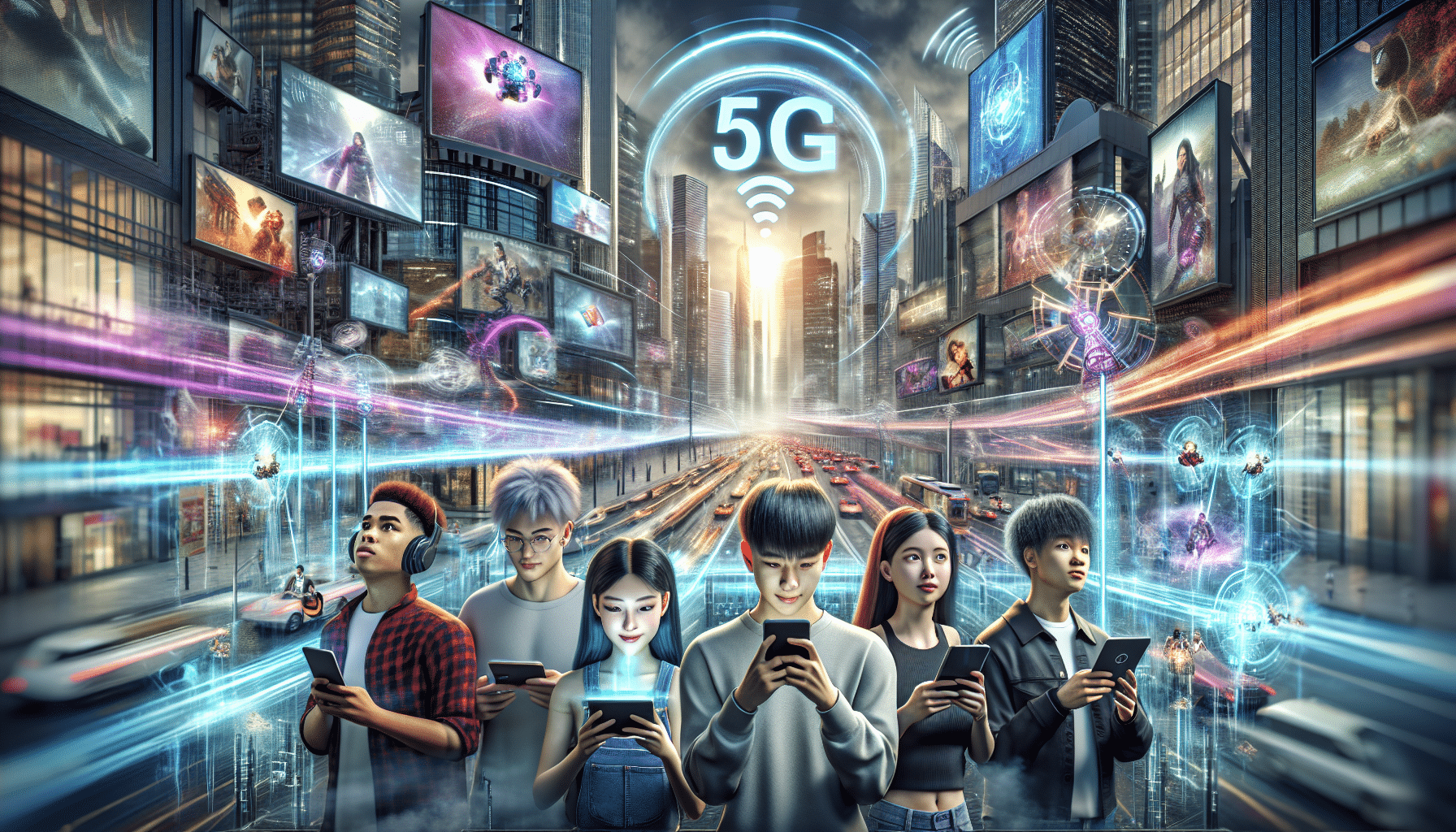Adverts
The technological revolution brought about by 5G is transforming not only the way we communicate, but also how brands connect with their audiences. In the gaming marketing scenario, this new era of connectivity promises to change the rules of the game, offering more immersive and interactive experiences. 5G’s high-speed, low-latency data transmission capacity opens the door to a series of opportunities that can significantly increase player engagement.
Adverts
In this context, gaming marketing is no longer just about ads and promotions; it’s about creating engaging experiences that take advantage of new technologies. With the arrival of 5G, brands have the opportunity to implement innovative marketing strategies such as augmented reality games and real-time multiplayer experiences. These tactics not only capture consumers’ attention, but also offer a level of interaction that was unimaginable with previous connections.
Additionally, 5G enables more precise audience targeting, enabling personalized marketing campaigns that speak directly to gamers’ interests. Real-time data analytics become a reality, allowing companies to adjust their strategies instantly, maximizing impact and return on investment. The future of gaming marketing is becoming more dynamic and responsive, and those who embrace these innovations will be one step ahead.
Adverts
In this article, we will explore the main ways in which 5G is revolutionizing gaming marketing. We will discuss new emerging technologies, engagement strategies and implications for the future of the industry. Get ready for a fascinating journey through the universe of opportunities that 5G is bringing to gaming marketing and discover how to take advantage of this wave of innovation. 🎮✨
The Impact of 5G on User Experience
The advent of 5G technology has revolutionized not only communications but also the way users interact with games. Reduced latency, increased bandwidth, and the ability to connect significantly more devices simultaneously are all features that transform the gaming experience.
One of the most notable aspects of 5G is the drastic reduction in latency, which can drop to less than 1 millisecond. This means that players’ actions are transmitted in near real-time, providing a smoother and more responsive gaming experience. Competitive games like eSports benefit greatly from this feature, as every millisecond counts in high-pressure situations.
Additionally, 5G’s ability to support high download and upload speeds allows developers to create games with more complex graphics and larger open worlds without having to worry about the player’s connection being a bottleneck. This opens up opportunities for innovation in massively multiplayer games and augmented reality (AR) and virtual reality (VR).
5G also democratizes access to high-quality games, allowing mobile devices and tablets to play titles that were previously exclusive to consoles or PCs. This evolution expands the gaming market, bringing new audiences who can access sophisticated content from their mobile platforms.
Marketing Strategies for Games in a 5G Environment
With the introduction of 5G, gaming marketing strategies need to evolve to take advantage of the new opportunities it offers. The ability to create immersive and interactive experiences opens the door to innovative marketing campaigns.
One of the most effective strategies involves utilizing augmented reality (AR) in advertising campaigns. Developers can create experiences that allow players to interact with game elements in the real world. For example, a marketing campaign for a new title could allow users to see game characters in their physical environments through their mobile devices, encouraging an emotional connection with the game.
Another strategy is to use game streaming, which becomes possible with 5G infrastructure. Games can be streamed in high definition without the need for extensive downloads. This allows players to try out games before purchasing them, increasing the likelihood of conversion. In addition, this approach can be used to create live events, where players and influencers interact in real time with fans.
To maximize impact, marketers should consider the following actions:
- Develop interactive content that engages players
- Leveraging influencers to promote real-time gaming experiences
- Implement AR campaigns that enable real-world interaction
- Explore live streaming of events and competitions
- Offer free trials for new streaming games
Personalization Through Real-Time Data
Real-time data collection and analysis are key to personalizing gaming and marketing experiences. With 5G’s improved connectivity, developers can access user data instantly, enabling them to quickly and effectively adapt their offerings.
Games can now collect information about player behavior, such as playtime, character preferences, and play styles. This information can be used to personalize the player experience by offering challenges that align with their interests and skills.
For example, if a player tends to choose characters with ranged attack abilities, the game can suggest missions that involve ranged combat, increasing player satisfaction and retention. Additionally, this data is also useful for marketing campaigns, as it allows advertisers to target their audiences more precisely.
Personalization can be further enhanced with the use of artificial intelligence (AI). Algorithms can analyze the behavior of groups of players and predict which game elements are most appealing to different audience segments. This leads to more targeted and effective marketing campaigns.
The table below exemplifies how the data collected can be used for personalization:
Player BehaviorSuggested PersonalizationMarketing StrategyPlayer who prefers RPGsOffering RPG-related quests and charactersCampaigns targeting new RPGsPlayer who enjoys racing gamesSpeed challenges with rewardsPromotions for new racing gamesPlayer who frequently interacts in co-op gamesIncentives to participate in co-op eventsMarketing of co-op game events
Development of Virtual Communities in 5G
With 5G, creating and strengthening gaming communities becomes more relevant and accessible. Fast connectivity allows players from all over the world to interact in real time, forming bonds and participating in collective experiences.
One of the most effective ways to foster these communities is through streaming platforms, where gamers can share their experiences and interact with their followers instantly. 5G makes it easier to stream games live in superior quality, allowing streamers to deliver a visually appealing experience with low latency. This not only increases viewership, but also engagement, as viewers can actively participate through live chats and real-time reactions.
Additionally, online events and tournaments can be organized more efficiently, attracting a larger player base. The ability to support large amounts of data and simultaneous connections means organizers can run competitions that bring together thousands of players and spectators without the technical issues that were a challenge with previous generations of connectivity.
Gaming communities can also be strengthened through social platforms, which allow players to form groups, share experiences, and collaborate on missions. This creates an environment conducive to loyalty and ongoing engagement.
The Future of Gaming Marketing with 5G
The future of gaming marketing in the context of 5G is promising and full of possibilities. The speed and efficiency of this technology will allow new formats of games and interactions to become a reality. Marketing will need to adapt quickly to new trends and consumer behavior.
One area that is expected to grow is the use of cloud technology, which enables access to heavy games without the need for robust hardware. This democratizes access and allows players of different financial conditions to have the same gaming experience, creating a more inclusive market.
Developers will also be able to further explore the potential of subscription-based gaming, where users pay a monthly fee to access a library of games. With 5G, the streaming experience could be as good as playing locally, increasing the adoption of this business model.
Furthermore, data-driven marketing will become even more critical. Real-time data analysis will allow marketers to adjust their strategies instantly, creating dynamic campaigns that adapt to player behavior.
Games can also incorporate gamification elements into their marketing campaigns, encouraging users to interact with the brand in new and innovative ways. This not only improves the user experience but also increases the likelihood of conversion and loyalty.
In short, 5G not only transforms the gaming experience, it also opens up a new dimension for marketing within the industry, creating unprecedented opportunities for developers and marketers to adapt and thrive in an ever-evolving landscape.

Conclusion
Connecting to the future is more than just a catchphrase; it’s a transformative reality powered by 5G technology. As this new era of connectivity unfolds, gaming marketing is set to undergo an unprecedented revolution. On one hand, 5G provides impressive download speeds and reduced latency, enabling more immersive and interactive gaming experiences. This, in turn, opens the door to more dynamic and engaging marketing campaigns, such as live streams of events and competitions, that capture players’ attention in real time.
Additionally, 5G’s ability to support a vast number of simultaneously connected devices enables a more integrated gaming ecosystem. As a result, brands can create personalized experiences, reaching specific audiences with relevant and engaging messages. This not only increases the effectiveness of marketing strategies but also improves consumer loyalty.
In short, as 5G becomes the norm, gaming marketers must embrace these innovations. Therefore, adaptation and innovation are not only beneficial, but essential to stand out in a competitive market. The future is now, and 5G is here to stay. 🌐🎮




